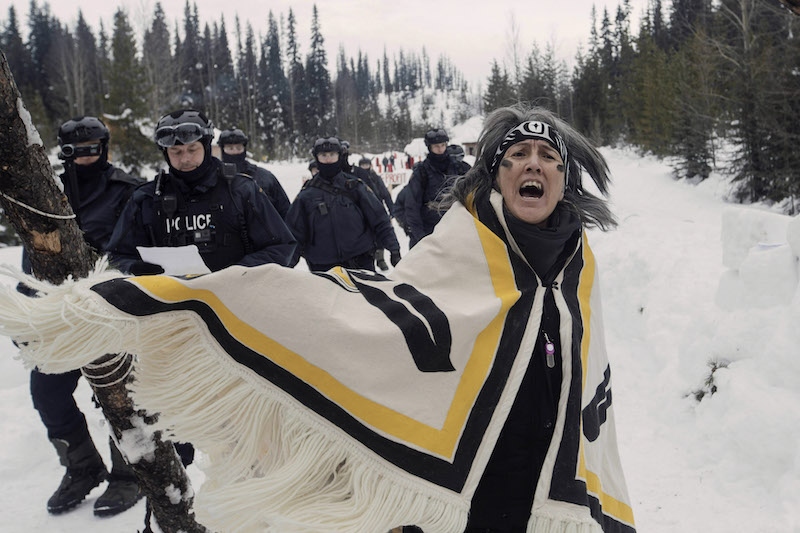Yintah is not just a documentary; it’s a powerful statement on Indigenous struggles for sovereignty over unceded territories.
The film centres on the Wet’suwet’en Nation’s fight against colonial encroachment, illustrating a fierce resistance against a Canadian government intent on seizing land for fossil fuel development. The 22,000 square kilometres of Wet’suwet’en land has never been surrendered, sold or legally placed under Canadian authority.
In 1997, Canada’s highest court confirmed the Wet’suwet’en hereditary chiefs’ (Dinï ze’ and Tsakë ze’) ownership of their territory. Despite this landmark ruling, the Canadian government has continued to authorize pipeline construction through Wet’suwet’en yintah (land), sparking a decade-long clash between Wet’suwet’en land defenders and Canadian police.
Yintah documents this ongoing struggle, highlighting key figures like Freda Huson, Molly Wickham and the hereditary chiefs.
As the traditional leaders of the Wet’suwet’en community, the hereditary chiefs are elected officials, as they are only chosen by Elders and other clan members after years of training and observation. Their authority comes from their deep knowledge of Wet’suwet’en laws, traditions and responsibilities, which they exercise by consulting matriarchs and other family and clan members to make decisions by consensus.
This system contrasts sharply with the elected band councils, a creation of the Indian Act imposed by the Canadian government. While there is often overlap between these two systems, their roles are distinct. Hereditary chiefs represent the territories as a whole, upholding Wet’suwet’en sovereignty and traditional governance, while elected chiefs manage and enforce reserve rules that remain from the Indian Act.
Tsakë ze’ Howilhkat Freda Huson is a wing chief of the Unist’ot’en people from the Wet’suwet’en C’ilhts’ëkhyu clan. Her journey as a leader in the Indigenous sovereignty movement began in 2011 when she made a pivotal decision to reoccupy her family’s ancestral territory.
Leaving behind a comfortable life, Huson chose to live directly in the path of a proposed pipeline corridor, making a powerful statement against the exploitation of Indigenous lands. Her leadership inspired other Wet’suwet’en families to follow suit, reclaiming their lands and asserting their rights. With the support of numerous allies, she established a healing centre on the land, providing a space for Wet’suwet’en people to heal from the deep-seated traumas of colonialism.
Tsakë ze’ Sleydo’ Molly Wickham, a wing chief of the Cas Yikh people from the Wet’suwet’en Gidimt’en clan, is another formidable force. For a decade, she has lived on unceded Cas Yikh territory in a cabin strategically positioned to protect a pristine lake from the threat of mining. Wickham is also spokesperson for the Gidimt’en Checkpoint, a critical site in the struggle against pipeline construction. As her clan reclaimed control of their traditional lands, Wickham found herself confronting police forces on her doorstep.
Directors Jennifer Wickham, Brenda Michell and Michael Toledano drew from more than a decade of frontline footage, following two Wet’suwet’en leaders as they reoccupy and protect their homelands in the face of state violence. This approach allows Yintah to mirror the scope of the Wet’suwet’en fight, offering what Wickham describes as “a remarkably cohesive account of a story that police worked hard to suppress.”
The film brings the viewer into the heart of the resistance, making the Wet’suwet’en people’s fight for sovereignty a shared experience. As director Wickham notes, the filmmakers themselves were not immune to the repression. “Throughout the years, our camera operators were held at gunpoint, repeatedly arrested and detained, subject to illegal police exclusion zones, surveillance, harassment and even incarceration,” she recounted.
Despite these challenges, Yintah stands as a testament to the power of media to challenge state narratives and support Indigenous sovereignty. The film’s creation was also an act of resistance, with every consequential moment captured on camera, offering an unfiltered look at a struggle that is deeply rooted in Wet’suwet’en history and legal traditions. Yintah shines a light on these contradictions between Canadian law and Wet’suwet’en sovereignty.
The 2011 Canfor v. Sam ruling by British Columbia’s Supreme Court acknowledged that Wet’suwet’en hereditary decision-making processes are integral to their society. Despite these legal recognitions, the Canadian and BC governments continue to assert jurisdiction over Wet’suwet’en territory, issuing permits for resource projects without the consent of the hereditary chiefs.
Toledano, also the film’s cinematographer, emphasizes the significance of documenting this struggle. “Wet’suwet’en people upholding decisions made in accordance with Wet’suwet’en law have been criminalized by the Canadian state,” he stated.

Arrests have been made for simply occupying and controlling access to traditional territories. As Toledano put it, “Colonial forces conspired to criminalize Wet’suwet’en jurisdiction, we as filmmakers worked to uphold it.”
Highlighting the collaborative nature of the filmmaking process, Michell notes that the film was developed with intensive participation from Wet’suwet’en leaders and co-directed by the immediate family members of the film’s protagonists.
“Adopting a decision-making structure which mirrors the practices of Wet’suwet’en self-governance, the film relied on collaboration and consensus-building to share this vital history,” Michell explained.
Yintah is a project deeply rooted in Wet’suwet’en governance, embodying the principles of ‘anuc niwh’it’ën (Wet’suwet’en law) throughout its creation. Wickham explains that each Wet’suwet’en family depicted in the film held decision-making power over their own representation.
“In Wet’suwet’en law, each house or family group is the sole decision-making authority on their house territories,” she said. “So, in Yintah, each house group was given creative authority over the representation of events on their house territories.”
This resulted in a process where the Dinï ze’ and Tsakë ze’ (male and female chiefs) and Skiy ze’ (children of chiefs) of the Wet’suwet’en “effectively guided and authorized the depiction of this vital chapter of Wet’suwet’en history.”
By adhering to Wet’suwet’en law, Yintah challenges the conventional power dynamics of filmmaking, where often the subjects of a documentary have little control over their portrayal. Instead, this film represents a decolonized approach to storytelling, where the Wet’suwet’en people have full control over how their history and struggles are depicted. As a result, the film is both an expression of Indigenous sovereignty and an attempt to decolonize history.





